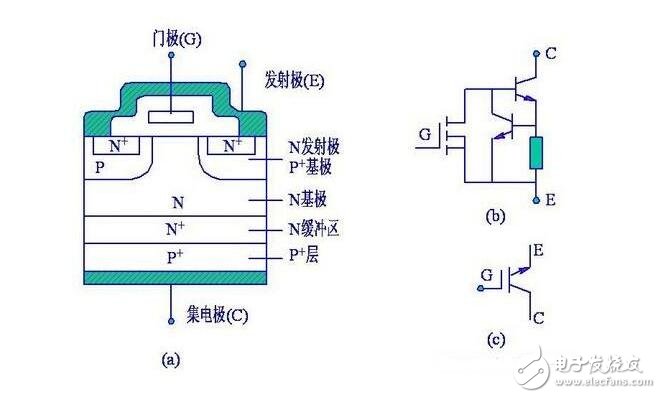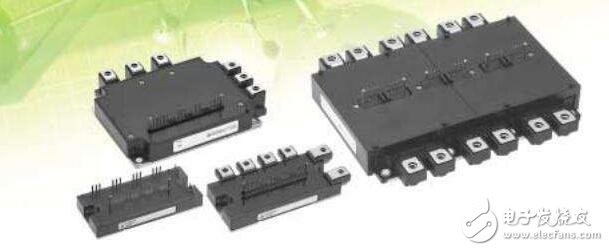IGBT (Insulated Gate Bipolar Transistor), insulated gate bipolar transistor, is a composite fully controlled voltage-driven power semiconductor device composed of BJT (bipolar transistor) and MOS (insulated gate field effect transistor), which has both MOSFETs. The advantages of both the high input impedance and the low turn-on voltage drop of the GTR. The GTR saturation voltage is reduced, the current carrying density is large, but the driving current is large; the MOSFET driving power is small, the switching speed is fast, but the conduction voltage drop is large, and the current carrying density is small. The IGBT combines the advantages of the above two devices, with low driving power and reduced saturation voltage. It is very suitable for converter systems with DC voltages of 600V and above, such as AC motors, inverters, switching power supplies, lighting circuits, traction drives, etc.

The IGBT module is a modular semiconductor product that is packaged by IGBT (Insulated Gate Bipolar Transistor Chip) and FWD (Freewheeling Diode Chip) through a specific circuit bridge; the packaged IGBT module is directly applied to the inverter and the UPS is uninterrupted. On the power supply and other equipment; IGBT module has the characteristics of energy saving, convenient installation and maintenance, and stable heat dissipation; most of the products currently on the market are such modular products. Generally speaking, IGBT also refers to IGBT modules; with the promotion of energy conservation and environmental protection concepts Such products will become more and more common in the market; IGBT is the core device of energy conversion and transmission, commonly known as the "CPU" of power electronic devices, as a national strategic emerging industry, in rail transit, smart grid, aerospace, It is widely used in electric vehicles and new energy equipment.
Operating characteristics of IGBT:Static characteristics of IGBT
The static characteristics mainly include volt-ampere characteristics, transfer characteristics and switching characteristics.
(1) volt-ampere characteristics:
The volt-ampere characteristic of the IGBT is the relationship between the drain current and the gate voltage when the gate-source voltage Ugs is used as a parameter. The output drain current is controlled by the gate-source voltage Ugs. The higher the Ugs, the larger Id. It is similar to the output characteristics of the GTR. It can also be divided into a saturated zone 1, an enlarged zone 2, and a breakdown characteristic 3 part. In the off-state IGBT, the forward voltage is taken over by the J2 junction and the reverse voltage is taken up by the J1 junction. If there is no N+ buffer, the forward and reverse blocking voltage can be achieved at the same level. After the N+ buffer is added, the reverse shutdown voltage can only reach tens of volts, thus limiting the application range of the IGBT.
(2) Transfer characteristics:
The transfer characteristic of the IGBT is a relationship between the output drain current Id and the gate-source voltage Ugs. It has the same transfer characteristics as the MOSFET. When the gate-source voltage is less than the turn-on voltage Ugs(th), the IGBT is turned off. Id is linear with Ugs over most of the drain current range after the IGBT is turned on. The maximum gate-to-source voltage is limited by the maximum drain current, and the optimum value is generally about 15V.
(3) Switch effects:
The switching characteristics of the IGBT refer to the relationship between the drain current and the drain-source voltage. When the IGBT is in the on state, its PNP transistor is a wide base transistor, so its B value is extremely low. Although the equivalent circuit is a Darlington structure, the current flowing through the MOSFET becomes a major part of the total current of the IGBT. At this time, the on-state voltage Uds(on) can be expressed by
Uds(on) = Uj1 + Udr + IdRoh
Where Uj1 is the forward voltage of the JI junction, which is 0.7 to 1V; Udr is the voltage drop across the extended resistor Rdr; Roh is the channel resistance.
The on-state current Ids can be expressed by:
Ids=(1+Bpnp)Imos
Where Imos is the current flowing through the MOSFET.
Due to the conductance modulation effect in the N+ region, the on-state voltage drop of the IGBT is small, and the on-state voltage drop of the IGBT with a withstand voltage of 1000V is 2 to 3V. When the IGBT is in the off state, only a small leakage current exists.

Dynamic characteristics of IGBT
During the turn-on process, the IGBT is operated as a MOSFET most of the time, except that after the drain-source voltage Uds falls, the PNP transistor is amplified from the amplification region to a delay time. Td(on) is the turn-on delay time and tri is the current rise time. The drain current turn-on time ton, which is often given in practical applications, is the sum of td (on) tri . The falling time of the drain-source voltage consists of tfe1 and tfe2.
The triggering and turn-off of the IGBT requires a forward voltage and a negative voltage between the gate and the base. The gate voltage can be generated by different drive circuits. When selecting these driver circuits, they must be based on the following parameters: device turn-off bias requirements, gate charge requirements, solidity requirements, and power conditions. Because the IGBT gate-emitter impedance is large, MOSFET drive technology can be used for triggering. However, since the input capacitance of the IGBT is larger than that of the MOSFET, the turn-off bias of the IGBT should be higher than that provided by many MOSFET drive circuits.
During the turn-off of the IGBT, the waveform of the drain current becomes two segments. Since the stored charge of the PNP transistor is difficult to be quickly removed after the MOSFET is turned off, the tail current of the drain current is long, td(off) is the turn-off delay time, and trv is the rise time of the voltage Uds(f). The drop time Tf of the drain current often given in practical applications is composed of two segments t(f1) and t(f2) in the figure, and the off time of the drain current.
t(off)=td(off)+trv ten t(f)
In the formula, the sum of td(off) and trv is also called storage time.
The switching speed of the IGBT is lower than that of the MOSFET, but it is significantly higher than the GTR. The IGBT does not require a negative gate voltage to turn off the turn-off time when turned off, but the turn-off time increases as the gate and emitter shunt resistance increases. The turn-on voltage of the IGBT is about 3 to 4V, which is equivalent to the MOSFET. The saturation voltage drop when the IGBT is turned on is lower than that of the MOSFET and is close to the GTR, and the saturation voltage drop decreases as the gate voltage increases.

Judging polarity:
First, dial the multimeter in R&TImes; 1KΩ gear. When measuring with a multimeter, if the resistance of one pole and the other two poles is infinite, the resistance of the pole and the other poles is still infinity after the switch is changed, then the extreme gate is judged. The remaining two poles are measured with a multimeter. If the resistance is measured to be infinite, the measured resistance is small after changing the test leads. In the case where the resistance is small, it is judged that the red pen is connected to the collector (C); the black pen is connected to the emitter (E).
Judging good or bad:
Place the multimeter in R&TImes; 10KΩ block, connect the IGBT collector (C) with a black pen, and connect the red pen to the emitter (E) of the IGBT. The pointer of the multimeter is at zero. Touch the gate (G) and the collector (C) with your finger at the same time. At this time, the IGBT is triggered to conduct. The pointer of the multimeter swings in the direction of smaller resistance and can stand at a certain position. Then touch the gate (G) and emitter (E) with your finger at the same time, when the IGBT is blocked and the pointer of the multimeter returns to zero. At this point, the IGBT is judged to be good.
Inspection notes:
Any pointer multimeter can be used to detect IGBTs. Note that when judging whether the IGBT is good or bad, be sure to set the multimeter to R&TImes; 10KΩ, because the internal Battery voltage of the multimeter below the R&TImes; 1KΩ is too low, the IGBT cannot be turned on when the detection is good, and the IGBT cannot be judged. . This method can also be used to detect the quality of a power field effect transistor (P-MOSFET).
Solar Power System Accessories
Solar Power System Accessories,Solar System Accessories,Solar Installation Kit,Solar Battery Kit
SUZHOU DEVELPOWER ENERGY EQUIPMENT CO.,LTD , https://www.fisoph-power.com
